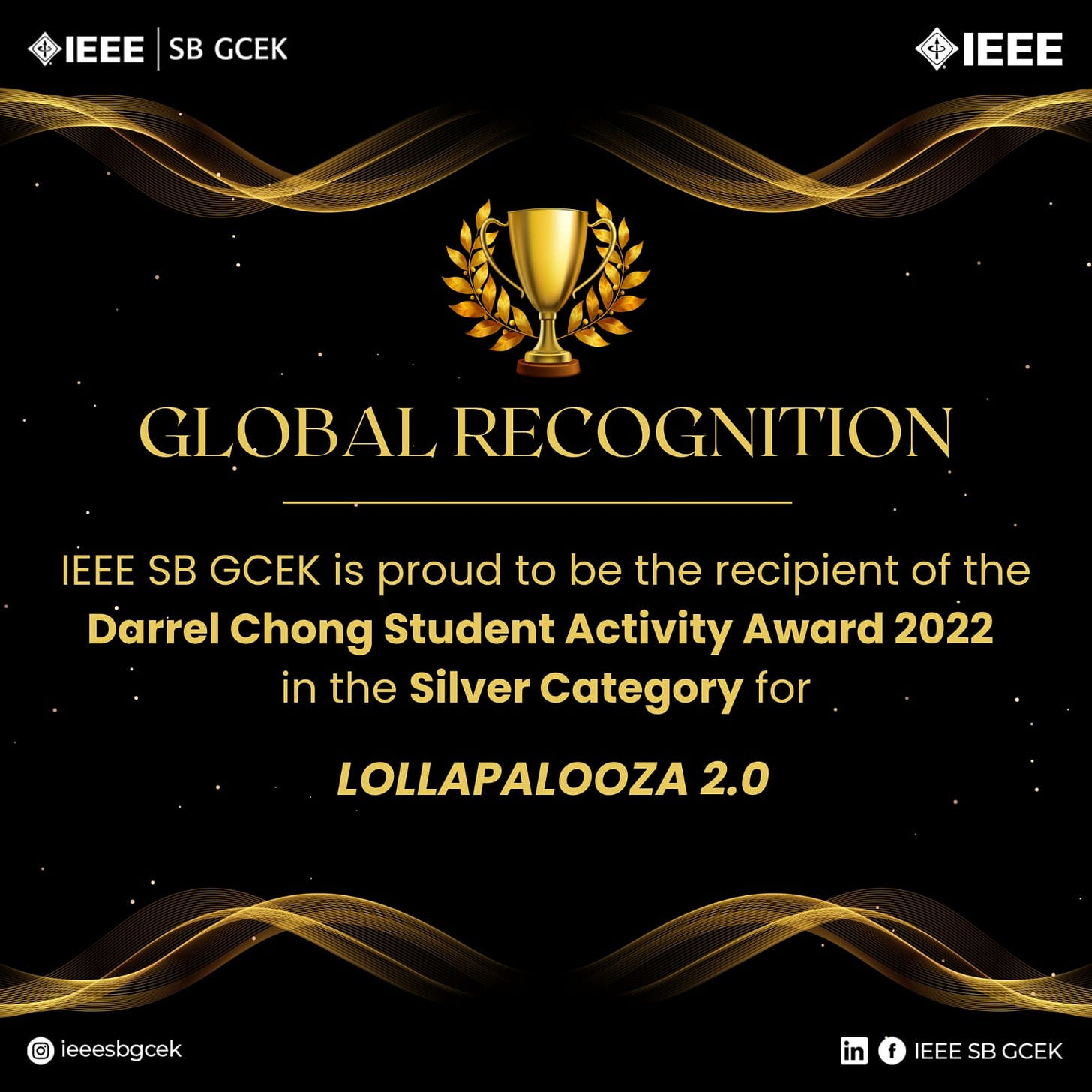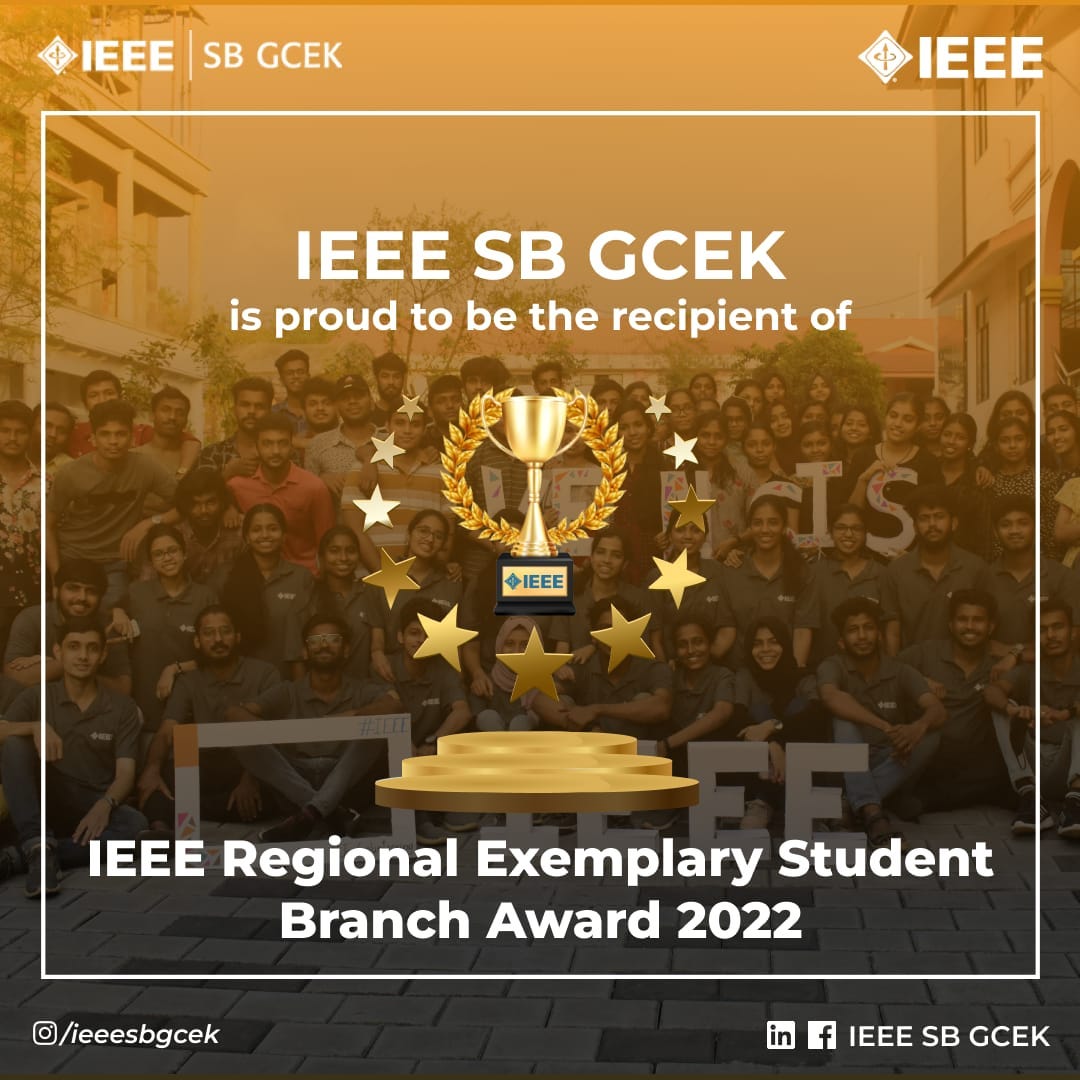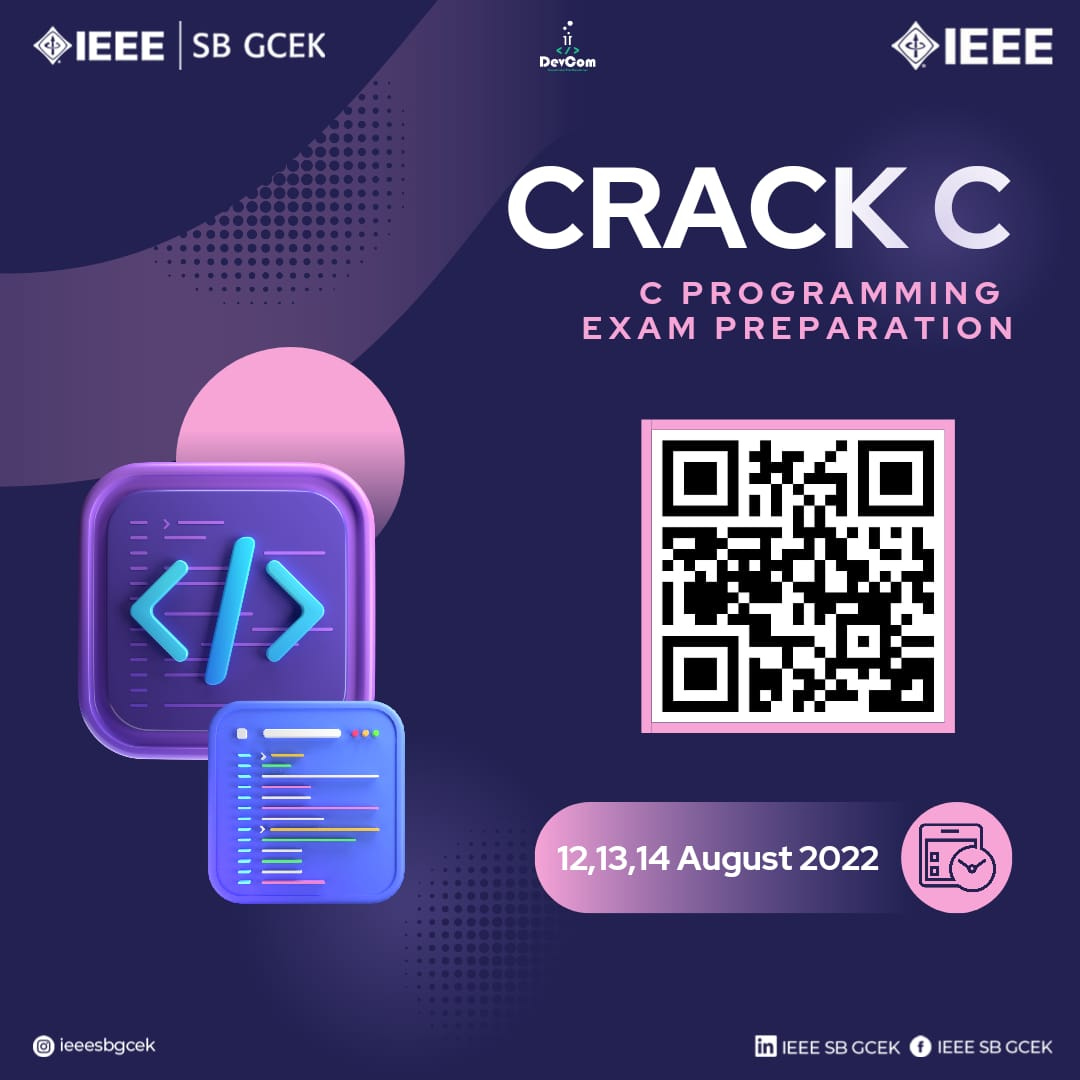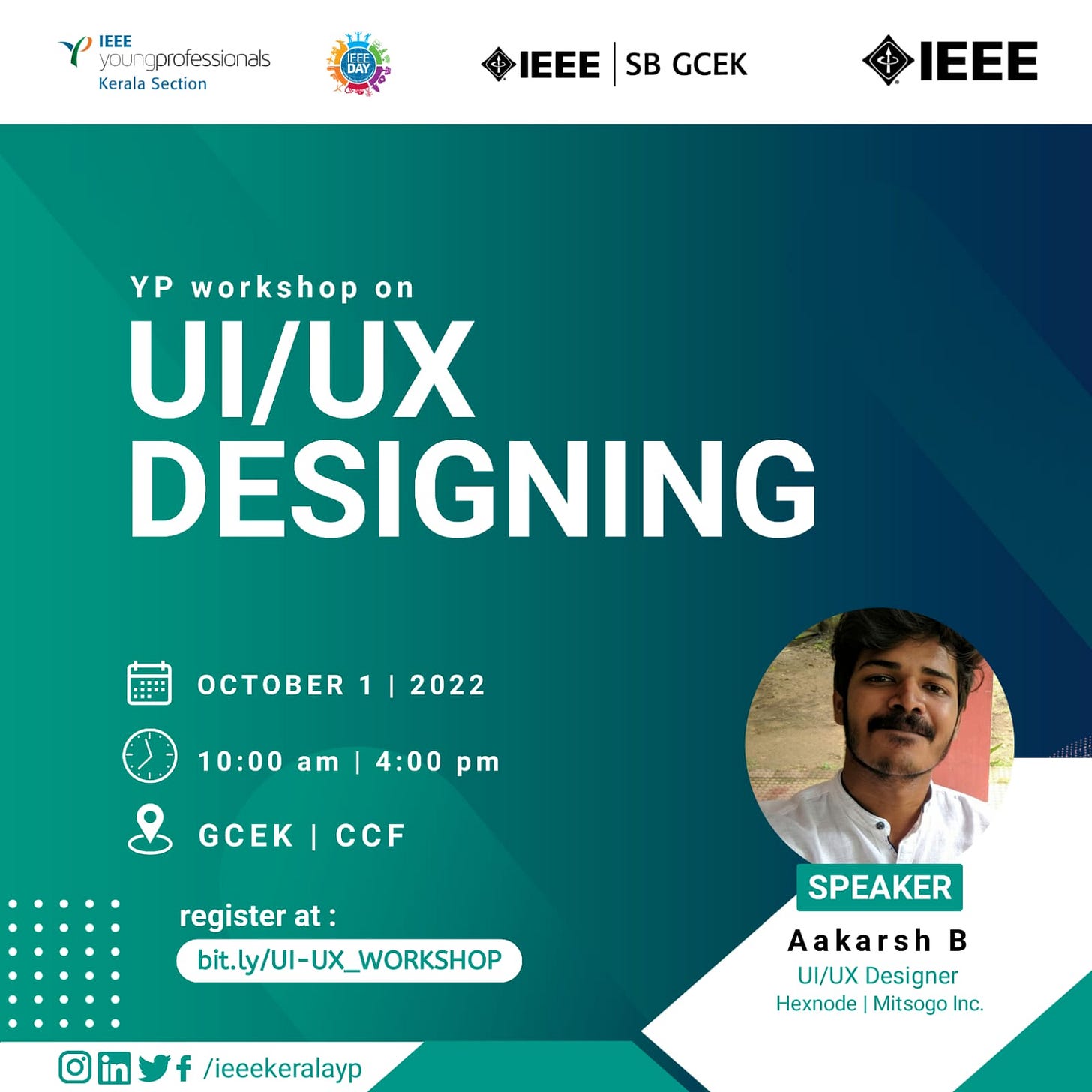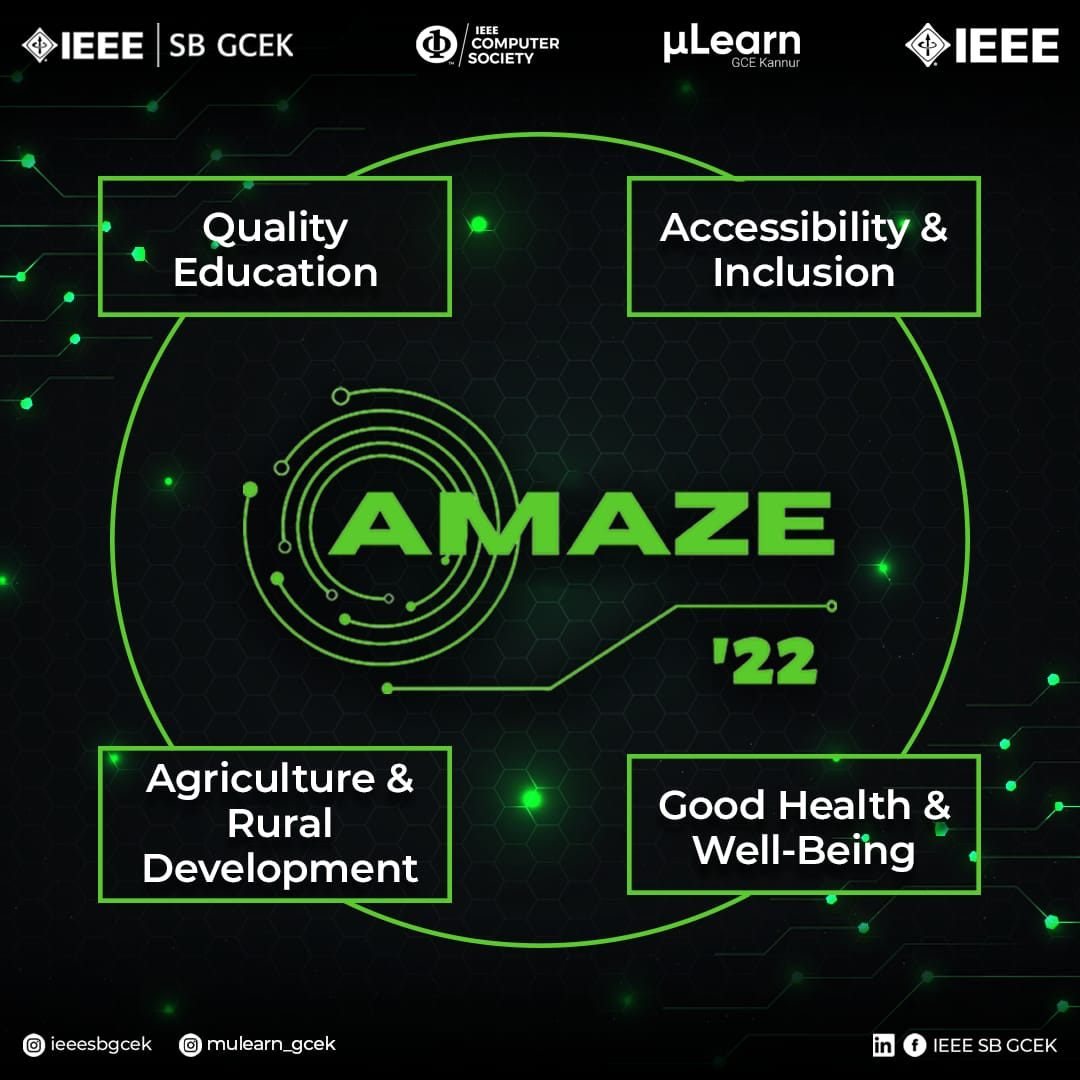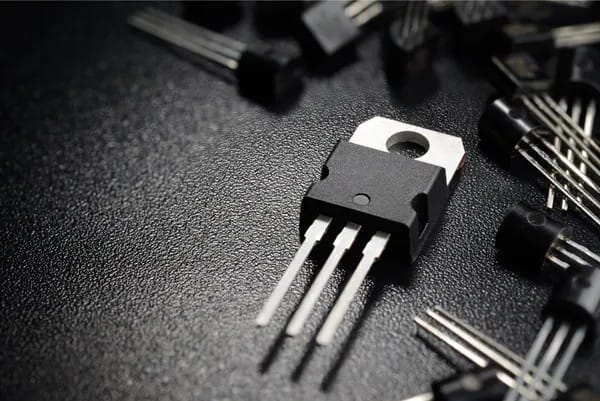Hello Guys!!
Hope you are all doing well 🤗. It’s been a long time since we have come up with the Tidings.
Come let’s read and inform ourselves with this edition! 😃
🍽What's Cooking
In this section, we bring you updates from our SB and IEEE that you shouldn’t be missing.
⭕ Achievements
IEEE SB GCEK acquired global recognition once again as it got selected as one of the Silver winners of The Darrel Chong Student Activity Awards 2022,for the event Lollapalooza 2.0.
IEEE SB GCEK has been awarded the IEEE Regional Exemplary Student Branch Award third time in a row.
⭕August 12-14,2022: CRACK C
As a part of Let's C,IEEE SB GCEK conducted personalised mentoring sessions for its members.The sessions were held online through Google meet.
⭕ UI/UX Workshop
As a part of IEEE day celebrations,IEEE SB GCEK hosted a Workshop on the topic UI/UX DESIGN. The event was scheduled on 01 October 2022 at 10 am which was open to all IEEE members. The session was held by Aakarsh B, UI/UX Designer at hexnode, Mitsogo Inc. The event had 32 attendees.
⭕ AMAZE ‘22
IEEE CS SBC GCEK is here with a 24-hour hackathon, AMAZE ’22 in collaboration with Mulearn GCEK on 12th and 13th November 2022.
The last date to submit the abstract is 6th November 2022 11:59 PM.
🔹 Catch the drift 💨
Technology is evolving so rapidly that it sometimes feels a bit tricky to get hold of it. So here we are to make you informed about new technologies that will make you catch the drift.
Evolution of Technology: 2 💻💡
In the last edition, we saw the many events that led to the technological advancements that we take for granted today, but thats not all. Many necessities we use today are the result of constant study and modification of what was discovered in the previous eras.
And in this edition, let’s see what the medieval period has to offer us. A large number of inventions came to be during the medieval period. Given that the medieval period was marked by perennial warfare throughout the different parts of Europe, most of the significant inventions of the period were directly or indirectly related to warfare.
However, there were other inventions such as the clock, printing press and architectural innovations which played a critical part in shaping medieval Europe. Here are some of the most important of these inventions from the medieval period.
1)Astrolabe: The Astrolabe was an important Medieval invention, They were used by navigators, and astronomers who studied the movement of celestial bodies .
2)Compass: It was in medieval Europe that the earliest versions of the modern compass as we know it were invented .
3)Printing press: The Printing Press was a very important invention in the Medieval history, Invented by Johannes Gutenberg in the 15th Century creating a 'printing revolution'.
4)Gun powder: Gunpowder had been invented in China as early as the 9th century but reached widespread use in Europe only by the 13th century.
5)Tidal mills: Tidal mills were an important medieval invention dating back to the 8th century. They were usually employed near natural water bodies such as rivers and were driven by the high tides of the water body.
6)Spinning wheel: In contrast to the earlier spinning methods used in Europe, the spinning wheel was far more efficient and allowed a spinner to spin greater amounts of thread in less time.
Depicted here are the the very few inventions among the vast advancements during the time. Apart from these instruments, there was significant evolution in the way buildings were created. Pre-Romanesque, Romanesque, and Gothic are the main styles used in Middle Ages architecture. While cathedrals and castles constitute the majority of the surviving Medieval structures, examples of municipal and Medieval-style houses may be found across Europe.
The Middle Ages were one of the most outstandingly creative periods in the whole of human history. It was then that the foundations of modern science were laid.
Stay tuned to dive deeper because we’re only one stop away from the last and final segment of this series.🤗
🤝 Rendezvous
Hearing from people who have traversed through the same path as us is always a great experience. So here is Rendezvous; a brief interview from the active members of IEEE.
In this Rendezvous, we have Ms. Shilpa Suresh, Software Engineer at Impelsys, Bangalore and our alumnus of 2k18 CSE batch. Come let’s have a walk through her experiences.
❓ Tell us about yourself. What's your current status?
✅ Hi, everyone. Myself Shilpa Suresh. I am a BTech Computer Science and Engineering Graduate of 2022 batch from Government college of Engineering, Kannur . Presently, I'm working as a software engineer at Impelsys, Bangalore. Well, yeah, that's about me and my current status.
❓ What made you join the IEEE community? Please, share your journey over the past years.
✅ Initially, I had no idea about IEEE, how it works or what it does . Also a thought never occurred to me to google it. Since everybody joined it I too decided to explore the excitements and adventures in IEEE. A thought of “Why don't I begin this adventure once?” made me join this big family. At the start, most of the sessions and talks were about the working and conduction of IEEE. Also there were some sort of workshops and technical stuffs. It was then the real adventure came in which never made me regretted joining IEEE. Whatever I enjoyed or explored throughout the four years of my life was because of IEEE. It gave me the most memorable moments and wonderful opportunities to express myself at different platforms and get networked with different people. All of it leading to me handling the position of treasurer at the final year of my BTech journey. Yeah well, IEEE is amazing if I had to say in a word.
❓ What were your goals as a BTech student? What would you like to accomplish as a graduate?
✅ Well, my life was never planned. And whenever I plan it, it never goes the same way. So most of what I have achieved in my life has never been part of my plans. Of course hard work and effort had it’s role as everybody says. Well, getting into a MAANG company is what I always wished for and still working for it. And talking about future I'm looking forward to pursue MBA. That's it.
❓ What changes or improvements would you like to add to the working of IEEE ? What were the hardships of working as an execom member, if any?
✅ Well, I would like to include more technical stuff into IEEE programs, not the regular ones, but something more fresh and exciting. Online event conduction in a way, is good, like, we get to perform multiple activities that are not possible offline due to multiple constraints. But I would suggest to shift from the culture of online to offline. Though online has become a very common medium nowadays, but I don't think it's a 100% effective channel to interact with people. It will be good if we have included more technical events , more different ones . Well, I hope more ideas come up with more people coming into IEEE.
❓ How about the transformation within you, from a teenager to a final year?
✅ Me before joining IEEE and after being an IEEE member is two different versions of me. Because if I weren't a member/an execom member of IEEE, I wouldn't have obtained such an exposure and I wouldn't have aquired the confidence to express myself and connect with different people. Participating in club activities like speeches, debates, online competitions unleashed me from the chain of being an introvert. It was IEEE that made me realize that the best version of me is within me and gave me the chance to find it.
❓ Could you please share the most mesmerizing experience you had working with IEEE?
✅ I would say volunteering is the best thing I have ever done. One of the spectacular experience was our trip to Malabar Hub Meet(MHM),Palakkad. The count was much less and we thought we couldn't make it. But at last there was an immense rush and the participation made a huge number. Our whole team coordinated so well that it was that moment we got to know each other. However we were a little bit shy, nevertheless it provoked us to break the shell. Oh, I miss those days.
❓ What were your possessions during this college period? How did you manage academics and execom duties?
✅ I was an IEEE member for the four years and in the final year I had been appointed as the treasurer of IEEE SB GCEK. Frankly speaking, it was very easy for me to manage both academics as well as execom duties ‘coz I have been blessed with a great team. The whole execom stood with me whenever I faced issues and we were always a family, nothing was taken personal even though everybody had their role to play. Treasurer duty was all about planning events and setting up budget but it never seemed difficult because my team made it much easier.
❓ Do you think being an active IEEE member changed your perspective towards the engineering career and its vast opportunities?
✅ In the present era, the priority always go to soft skills, the way you handle things and your leadership qualities and communication skills matter a lot. As I mentioned earlier IEEE gives you the dias to speak up your mind. Actually I was an ambivert during the initial days. But when I started getting involved in IEEE I got to discover my new face, the one who would actively wait to seek the oppurtunity and run to be the first to speak out.
❓ A newbie always finds it difficult to start his/her journey and this might affect their whole career. So, what would you suggest for your juniors to get into the track? (Like, is it about randomly participating in all events or choosing based on your interests)
✅ I would say, it’s a mix of both. If you are confident enough to participate in an event,go for it. Otherwise especially regarding technical events take the opportunity and give it a shot. You need not be well versed in anything, participating in those events and interacting with people teach you more things. Try out the new and learn from your mistakes, you’ll make mistakes and its totally fine. However, keep in mind –“Never ignore your mistakes”. That’s how you get to know things. And also this will help you explore yourself, explicitly your strength and weaknesses. IEEE provides a lot of technical events like workshops to improve your coding skills, soft skills and so on, actually they train everybody. I know people from different branches rather than computer science who excel in coding in one way or the other. That’s how IEEE prompt you to get better. You’ll have to do only one thing, just grab your opportunity and buckle up for the race.
❓ Being an active IEEE member attending various events and interacting with people from different backgrounds, and various sessions with experts from the specific background; Was it anyway beneficial during your placement interviews and building you career?
✅ Yes of course. As I had already mentioned about the soft skills,IEEE is a great platform to raise your voice and speak for yourself. Your thoughts are heard by everyone once you enter IEEE. That made me more confident than how I was during my first year. The present world looks up for someone who would take the initiative. Nobody would approach you until and unless you have made your space.So you’ll have to make one. First and foremost thing to expose your potential is nothing but CONFIDENCE to stand for yourself. And that’s what IEEE train you for. Personally, I love coding and IEEE made me enthusiastic in coding through the events which were all fun filled as well as enlightening.
🏫 Epistemology
Whatever the skills be, you master it only when it is applied to real - life problems or when you get hands-on experience with it. Here is Epistemology to guide you through some great resources on the web to get good at something :)
THE POWER OF GOOD COMMUNICATION SKILLS
Being able to communicate effectively is perhaps the most important of all life skills. It is what enables us to pass information to other people, and to understand what is said to us. In this article, define what effective communication looks like, discuss its benefits and offer ways to improve your communication skills.
Active Listening 👂🏻
Effective communication is about listening rather than talking. You can be the most interesting person, but if you don't know how to listen, you can’t build connections with people.By listening, concentrate on what the speaker says both with his or her words as well as the body language.
Being Assertive 🧘🏻♂️
Assertiveness is the ability to clearly state your opinion, needs and wants without disrespecting the rights of other people. Being assertive can get you what you want without damaging relationships.
Being assertive is about having a good balance of confidence and humility. It’s about being comfortable with yourself.
Storytelling
Story is one of the best ways to relate your ideas to the audience. If you want to persuade people or to inspire them, tell them a story so that they can relate to the situation.
Writing Down Your Thoughts ✒️
A good way to develop your written communication skills is to keep a journal to write down your thoughts and feelings. This will help you to clarify your thoughts and to enable you to put them into words.
Know When To Vent And When To Wait
Every word you say and every action you take can either help your career or hurt it. Remember no one is perfect. When things go wrong, keep calm and carry on. You should vent-but only when it’s appropriate to do so. You don’t need to be an expert communicator to know venting in the wrong way or at the wrong time.
Asking Questions 🙋🏼♀️
When you are meeting with someone new,the most effective way to get things done is to ask questions.A good question can go a long way toward making the other person feel more comfortable and less threatened.
Use humour appropriate and effectively
Humour is a tricky thing and can get you in trouble if you don’t use it right.It breaks down barriers,reduces stress and tension.Humour can be a great way to get attention.Make sure that your humour is positive-not sarcastic or condescending.
Non-Verbal communication
Face to face communication is so much more than words on a page.In fact,only 7 percent of our communication is verbal,the rest is non-verbal.
When you are communicating with someone,pay attention to their body language,this can give you insight into how well your message is being received.
Empathy and compassion
Empathy is the ability to understand and share someone else’s emotions.If you can’t see things from someone’s perspective ,it’s hard to relate to them or help them solve problems.It makes us better at listening and understanding.
Inclusive Language
Don’t assume that everyone understands industry jargons or even the context of what you are saying.You can avoid alienating people by using inclusive language.Benefit of using inclusive language is that it can help foster a more creative workspace.
Tone and Volume 🔊
Tone and volume of your voice play a crucial role in setting the right atmosphere for a productive conversation.Generally,a calm and consistent tone of your voice is prefered to connect better with your audience.
Apart from tone,volume matters a lot.It is important that you balance both to make people more comfortable communicating with you.
👨🎨 From our Coterie 👩🎨
Our SB is filled with people who excel at every niche. And that is one of our greatest strengths. So we bring the best works from our coterie.
In this edition, we bring you an article written by Urmila T V of 2K21 ECE B.
The innovation of Advanced MOSFET Technology for the next Generation
It has been observed that after every two years the number of transistor in a dense integrated circuit (IC) doubles and is approaching the capacity of wired communication system by Moore’s law. For careful observation of an emerging trend Moore extrapolated that computing would dramatically increase in power and decrease relative cost , at an exponential pace. So new technologies are needed which should have high data handling capacity.
Modern semiconductor devices are becoming more compact, faster, and more complex. To stay ahead of the curve in this rapidly evolving industry, semiconductor manufacturers must continually find new ways to reduce costs while also raising performance levels. To do this, manufacturers must continuously refine their current manufacturing processes to make them faster, less expensive and more reliable. In the world of semiconductors, these methods are called “process innovation” or sometimes simply “manufacturing innovation.” These concepts can be applied to any type of production process in which a final product is produced from raw materials by a series of discrete steps; it doesn’t just apply to semiconductors. This article explores the various innovations that advanced MOSFET technology has brought into existence for the next generation of integrated circuits.
What is MOSFET ?
A MOSFET is a type of transistor that is made out of silicon. Here, silicon refers to the semiconductor material out of which MOSFETs are made. MOSFETs are made by joining a source, a drain, and a gate together. The gate voltage can be used to turn the MOSFET on or off. Most MOSFETs are used for highpower applications like powering motors, controlling electrical circuits, or regulating power. MOSFETs are often used in circuits that control things like household appliances, cars, and industrial machinery.
The two most important innovation processes for process engineers are design for manufacturability (DFM) and design for reliability (DFR). Design for manufacturability is about designing the architecture of an IC or a system in a way that makes both the design and the manufacturing process more robust. DFM focuses on reducing the number of masks used in an IC design, keeping the IC design simple, reusing what has already been proven in other designs, and identifying the right process technologies that are most suitable for the design. Design for reliability is about designing circuits in a way that ensures they will continue to operate even in the face of random defects that may have been introduced during the IC fabrication process. DFR involves designing circuits that can tolerate high levels of defects, keeping voltage levels within safe limits, and applying error detection circuits.
The semiconductor industry relies on automated transport systems to move materials to and from manufacturing lines. These transport systems include robots, carousels, conveyor belts, and overhead cranes. Semiconductor manufacturing equipment often requires extremely precise positioning of parts, tools, and other components. For example, when manufacturing ICs, semiconductor manufacturing equipment often needs to precisely position photoresist masks, chemical etching solutions, or other chemicals. Transport systems used in semiconductor manufacturing equipment typically need to meet very high accuracy and precision requirements. Due to the large number of parts, tools, chemicals, and other items that are transported to and from manufacturing lines, semiconductor manufacturing equipment often uses overhead cranes and carousels to move materials. Overhead cranes are used to lift and move parts and tools. Carousels are sometimes used to move materials between work stations.
For large semiconductor manufacturing equipment that includes numerous carousels, an automated carousel transport system is often used to move carousels between work stations.
The semiconductor industry has come a long way since its inception in the 1950s. The semiconductor industry became commercially viable in the 1960s when manufacturers began using silicon as the semiconductor material instead of the germanium that was used in the first semiconductor devices. Silicon devices had a higher switching speed than germanium devices. As silicon devices became more widely used, manufacturers began using photolithography to pattern the intricate designs of their devices onto silicon wafers. The rise in adoption of the Internet and digital communication, coupled with the availability of advanced MOSFET technology, has made life easier for everyone, even semiconductor manufacturers. With these innovations, semiconductor manufacturers can deliver better and more costeffective products faster than before.
Hope you enjoyed the tidings.
Your comments are valuable for us to improve.
We’ll greet you next month with some good tidings.
Until then, adios amigo! 👋



